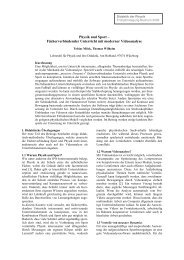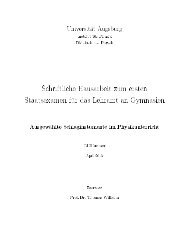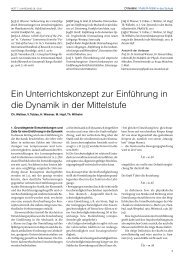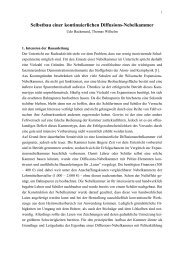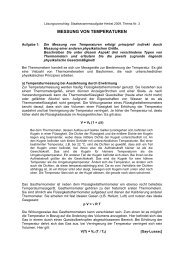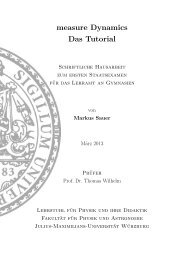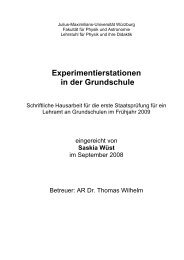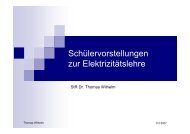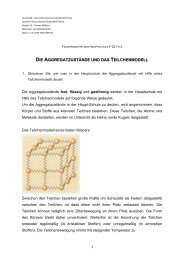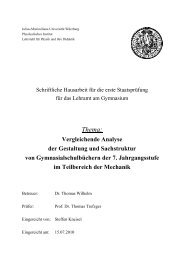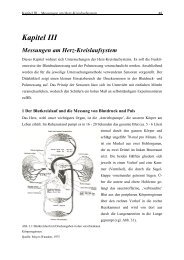Konzeption und Evaluation eines Kinematik/Dynamik-Lehrgangs zur ...
Konzeption und Evaluation eines Kinematik/Dynamik-Lehrgangs zur ...
Konzeption und Evaluation eines Kinematik/Dynamik-Lehrgangs zur ...
Sie wollen auch ein ePaper? Erhöhen Sie die Reichweite Ihrer Titel.
YUMPU macht aus Druck-PDFs automatisch weboptimierte ePaper, die Google liebt.
264 9 Abstract<br />
learned. Moreover, 83 % of the students agree with the statement that the point of a physical problem<br />
is finding the correct equation. The graduation of the items into the different subscales can be<br />
viewed critically, however, due to factor analysis and reliability analysis. It was furthermore observed<br />
that there is a certain coherence between the conception of the nature of physics and of<br />
studying physics on the one hand and the <strong>und</strong>erstanding of the Newtonian force concept on the<br />
other hand, respectively, there is however no coherence between these conceptions and the normalized<br />
gain in learning in Newtonian mechanics (chapter 6.6.4).<br />
All in all this means that traditional mechanics instruction <strong>und</strong>erachieves by far and results in only<br />
little qualitative <strong>und</strong>erstanding.<br />
9.2 Ideas of the developed teaching concept<br />
Dynamic-iconic representations illustrating physical quantities in motion allow the teacher to present<br />
physical quantities and statements in different ways (chapter 3.2). The temporal process of a<br />
physical quantity as well as the interrelations between different quantities can be displayed on different<br />
abstraction levels. Within the developed teaching concept dynamic-iconic representations<br />
were used as an auxiliary means to change students’ conceptions, especially the representation of<br />
vectorial quantities by dint of vector arrows.<br />
This allows for an introduction to kinematics via a general two-dimensional motion, with which<br />
kinematic quantities are introduced (chapters 5.3.1 – 5.3.2). Thus the students become acquainted<br />
with the vectorial nature of the quantities velocity and acceleration. The examination of the vector<br />
“change in velocity” v �<br />
∆ can furthermore be seen as the elementarization of the acceleration vector.<br />
For the acquisition of measured quantities of two-dimensional motions four different possibilities<br />
are suggested (chapter 5.3.3), whereas the PC-mouse is mainly used for implementations in class as<br />
well as for student exercises.<br />
In dynamics, this representation and continuous measurement can show that the Newton’s Second<br />
Law applies at all times, even <strong>und</strong>er the condition of variable force. Experiments with several forces<br />
and friction forces as well as more complex experiments on Newton’s Third Law are also possible<br />
� �<br />
(chapters 5.3.4 – 5.3.6). Newton’s Second Law is being outlined in the form a = ΣF<br />
/ m .<br />
Iconic representations can also be applied in qualitative exercise- and test problems requisitioning<br />
<strong>und</strong>erstanding. The representations moreover provide for demanding exact predictions from the<br />
students previous to conducting the experiments (student activities), mainly regarding relevant<br />
quantities and regarding the arrows representing them, with their directions and changes (chapter<br />
5.4.4). That way, students can be again and again challenged to actively think.<br />
Another iconic representation is used for creating networks of variables and relations (we call them<br />
“effect networks”) in order to make all interdependences of the quantities and thus structural interrelations<br />
clearer (chapter 4). These networks of variables and relations can be automatically implemented<br />
into a computing program by a software for graphic modelling, and the physical progression<br />
can be calculated. Creating models on dynamic sequences helps to clarify own conceptions of structural<br />
interrelations, and the progression with animations gives feedback. That way, misconceptions<br />
are cleared and the few basic equations of mechanics are emphasized.




